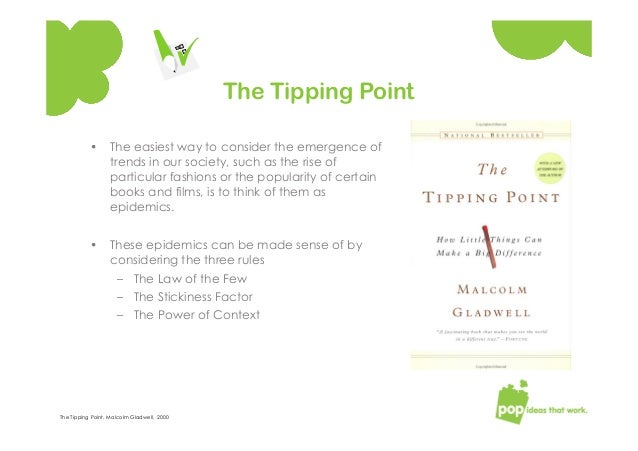

This is very similar to the 80/20 rule in some cases. In other words, tipping points are only reachable when enough pressure beneath the surface has built up to allow for an explosion. #7 Tipping Points Don’t Arise in a VacuumĪlthough Gladwell makes it seem as though brought shifts in human behavior and social organization can change in an instant, he also makes it clear that tipping points are only reached after there are enough factors in place to allow for the spreading of an epidemic.
#Tipping point law of the few tv#
Whether it’s about the individuals responsible for spreading ideas and epidemics, the power that small contextual changes in an environment can have, or how minor alterations to a tv show can cause it to become inordinately sticky, Gladwell makes a convincing case that minor things can have huge ramifications if they reach the tipping point. This is perhaps the single greatest take away from this book. Modern examples include influencers and celebrities, especially with the advent of the Internet. Such people have an inordinate amount of social weight when developing new trends or spreading ideas. They are the “few” described in the first rule of epidemics. Gladwell identifies these as the primary category of people responsible for spreading ideas. As police agencies made decisions to tackle smaller crimes with much greater vigor than before, the criminal “context” of the city decreased, and it became safer over time. His famous example follows the reduction in crime in New York City. The third rule of epidemics is that the context of an environment is what truly allows an epidemic, either biological or abstract, to spread. It just needs to be memorable enough that it remains in the minds of the public or key individuals long enough to spread to others. An idea does not have to be traditionally attractive to the appropriately sticky. The second rule of epidemics describes how successful viruses and ideas must both be “sticky” – that is, they have to be attractive or virulent enough to attach themselves to lots of people in rapid succession. If an idea or disease doesn’t infect the right people, it won’t spread it no matter how virulent its other attributes are. It only takes a few individuals in the areas or demographics to give a virus or idea the reach it needs to spread quickly throughout a population.

The first rule of epidemics broadly states that they are started by only a few people rather than many.

Gladwell discovers that ideas can spread just like real-world biological epidemics, and so goes over the three rules of epidemics to see if they match up with how ideas morph and spread throughout the world. The main thrust of this book explores how ideas – whether they are trends, laws, or social thoughts – spread throughout society. A 3 Minute Summary of the 15 Core Lessons In the book, he describes his theories about how ideas, like biological epidemics, spread through societies and why they behave the way they do. The Tipping Point is a 2000 book by Malcolm Gladwell, based on research he did as a journalist.


 0 kommentar(er)
0 kommentar(er)
